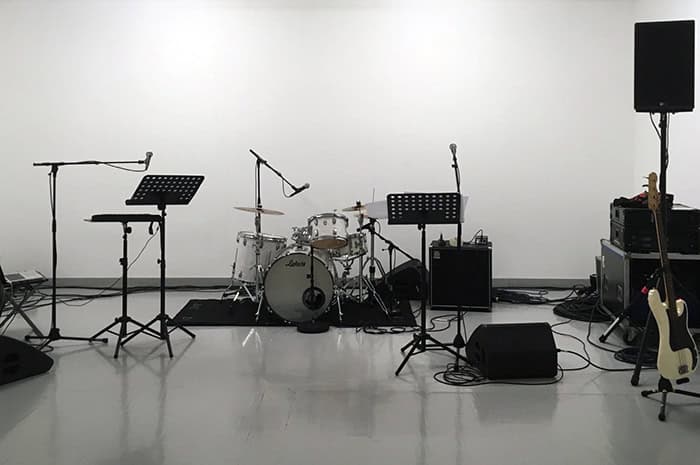Mette Edvardsen in Music for Lectures at Fest en Fest
Posted: March 4th, 2020 | Author: Nicholas Minns | Filed under: Festival, Performance | Tags: Andrei Tarkovsky, Dora Garcia, Fest En Fest, Francesca Fargion, Franz Kafka, Jonathan Burrows, Matteo Fargion, Mette Edvardsen, Ralph Waldo Emerson, Søren Kirkegaard, The Beatles | Comments Off on Mette Edvardsen in Music for Lectures at Fest en FestMette Edvardsen, Music For Lectures/every word was once an animal, Fest en Fest, February 9

It’s a welcome opportunity to see Mette Edvardsen again at Fest en Fest after last year’s No Title. She brings not a solo work but a collaboration with Jonathan Burrows, Matteo Fargion and Francesca Fargion: Music for Lectures/every word was once an animal. The setting is not a stage but one end of the Fuel Tank bar, against a door with a no entry sign on the outside. It’s a wet, stormy day and some people enter through it anyway to avoid an extra walk around the building. Seats are improvised, cushions are laid on the floor and Edvardsen is seated facing them cross-legged on a mat with microphone in hand. She is backed (or sided) by what is called a rock band consisting of Burrows on drums, Fargion senior on bass and Fargion junior on keyboard, but the musical style is more affected minimalist than rock.
Once she begins her text in her deadpan Norwegian lilt, it is clear that Edvardsen’s discursive lecture, both in its rigorous construction and in the patterns of her thinking, is in fact a choreography of words and ideas that move with the fluidity of an enchaînement. That she remains seated is inconsequential; we can see the movement behind our eyes. She begins with a characteristic digression by saying she had once thought her title, ‘every word was once an animal’, was a quote from Ralph Waldo Emerson, but her memorisation of the misquote — its repetition in her memory — had value since it led her to read all Emerson’s works and what others had written about him. The way Edvardsen’s words contain meanings that spread out into other meanings like an endless stream of associations is perhaps something she has learned from Emerson. In fact, it wasn’t a digression at all, but a repetition of something that Edvardsen had prepared, rehearsed and was now performing.
The meaning of the English words ‘repetition’ and ‘rehearsal’ is joined in the French ‘répétition’, and Edvardsen takes us through aspects of the word’s signification, teasing its many cultural connections and spatio-temporal ramifications, from the micro-cosmos of performances, rituals, and daily routines to quantum explanations of space-time. She integrates a story about the filming of the burning house in Tarkovsky’s Offret (The Sacrifice), examples of the Spanish artist Dora Garcia, the Beatles’ song Number 9 and considers the proposal of an alternative universal rhythm with a Big Bang followed by a Big Crunch followed again by a Big Bang.
Repetition acts both as an affirmation and a procrastination, a looking back but also a distillation of possibilities in the future. Quoting the Danish philosopher Søren Kirkegaard, Edvardsen reminds us that repetition and recollection are the same movements but in opposite directions, because in recollecting what has been, one also repeats it. Such an economy suspends the repetition of the past in the future, giving rise to the entropy of what Edvardsen refers to as a ‘non-concept’. Through her diverse references Edvardsen is not merely illustrating repetitive patterns but turning them into a choreographic lecture as a way of knowing.
Throughout, Edvardsen never loses the thread of associations; she does, however, find a red thread stuck on her sock but this, she reminds us, is a repetitive digression at the core of any performance and of the performing arts: the rehearsal of a pattern that is never the same and yet not so different as to be unrecognizable.
In a previous project called Time has fallen asleep in the afternoon sunshine, Edvardsen associated the memorisation of a book with the way a dancer learns choreography in rehearsal, and a live reading with performance. A copy of one of the books in the project was Franz Kafka’s Metamorphosis, but the memoriser’s copy was beginning to fall apart from wear (it can happen to a dancer, too). When she replaced it with a new one she was horrified to find the opening line was a different translation. By repeating the same line in a number of English translations, Edvardsen demonstrates how each iteration of a gesture, a word, a phrase or a verse can create a different image or association. As Emerson actually wrote, ‘Every word was once a poem.’
Fest en Fest offers its audiences examples of what it calls ‘expanded choreography’. The symbiotic link between language and dance that Edvardsen develops through the medium of the voice — with or without an accompanying band — is a perfect example.